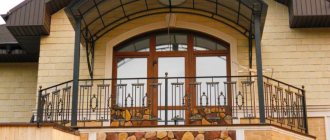A staircase on a balcony or loggia is a detail that irritates any owner and cannot be gotten rid of. However, it is within your power to make the appearance of a balcony with a fire escape and hatch more aesthetically pleasing, and the design can be implemented in different ways. We understand reconstruction methods, choose the optimal location, and study popular decorating ideas.
When stairs don't get in the way Source hzcdn.com
The purpose of the staircase and the consequences of its dismantling
The name clearly indicates this - a fire escape is used as an emergency exit for evacuating people in dangerous situations. Lucky are the residents of houses whose designs include a special smoke-free staircase, internal (which is located near the elevator shaft) or external. The structure, located on the wall of the house, does not poison the life of the owners of balconies.
For those less fortunate, the balcony is “decorated” with an inconvenient detail that causes an irresistible desire to get rid of it. However, it is a general property, part of the evacuation route, which is recorded in the fire safety rules.
Guarantee of your safety Source ytimg.com
What makes the situation worse is that the staircase is complemented by a hatch; together they form the very path of salvation in emergency situations. It is understood that they must be accessible at all times and that responsibility for their proper condition rests with the property owners.
The vast majority of owners would like to get rid of the fire escape; some people put their desires into practice. Many approach the issue decisively. They simply remove an unpresentable interior detail: the staircase is cut off and the hatch is welded shut. They are not stopped by the fact that unauthorized disposal is fraught with various legal consequences, in the “best of the worst” cases – administrative, in the worst – criminal.
A minority tries to disguise the structure or play around with it in some way. The method is not as radical as the previous one, although the question of using the ladder in a critical situation still remains.
When a structure takes up a third of the space Source homeli.ru
Why does she interfere?
Few people are satisfied with a metal structure that “eats up” the precious area of the balcony. The desire to dismantle the stairs is explained by the following reasons:
- It interferes with the use of space for domestic purposes. If the balcony is small, a bicycle will definitely not fit on it.
- The owners fear for the safety of their home and try to install protection, because stairs and hatches are an easy way for intruders to enter the apartment.
- You are dreaming of redevelopment, but combining a room with a balcony that has an emergency exit is not a good idea.
- You want to glaze your balcony to make it convenient for use at any time of the year.
- You want to make your balcony beautiful, decorate it in a certain style.
There is no place for stairs here Source pinimg.com
Fire escapes in documents and in reality
The rules for the installation and operation of fire escapes are prescribed in documents SNiP 21-01-97 on fire safety of buildings and structures. In each specific apartment building, the presence of a spare evacuation descent (and its parameters) is regulated by design documentation.
An apartment building includes not only private property (apartments), but also common areas. This category includes staircases and halls, elevators, basement and attic spaces, and utility rooms. Many owners do not even suspect that a balcony with a fire exit ceases to be their property when an emergency arises.
Therefore, owners are prohibited from dismantling emergency passages or interfering with their use in any way (welding the hatch or installing bulky objects on it).
The escape route must be clear Source vseobalkone.ru
See also: Catalog of companies that specialize in designing country houses
In practice, management companies should take care of the condition of emergency exits, but given the deterioration of other structures and communications, practically no attention is paid to staircases. As a result, loose, rust-covered stairs and hatches turn out to be useless in extreme cases and pose a threat to the health and life of residents.
Even if the design has outlived its usefulness, you should not get rid of it immediately. It would be more correct to inspect your evacuation zone to determine which of the neighbors in the entrance has already dismantled the stairs. If in most apartments the escape route is preserved, you should not become the one who will disrupt the functionality of the system and block the escape route.
If it turns out that the neighbors above and below have long since gotten rid of rusted structures, the only fire escape on your balcony ceases to justify its existence. You get the moral (but not legal) right to dismantle it. However, it is useful to remember that the action is still interpreted as a violation of the law, and the responsibility for dismantling remains with you.
The security system can be disguised behind false panels Source remontbp.com
FAQ
Do you need an emergency exit ladder on the balcony?
- Yes, if they already exist.
Is it possible to remove (cut, saw down, dismantle) the emergency exit ladder from the balcony (loggia), and what is the fine for this?
- The question already has an answer - it’s impossible. Whether the owner can be fined for this is a difficult question in practice. But the management company, on its own initiative, or rather on the orders of the federal fire inspector, will certainly find leverage to force the apartment owner to restore this emergency exit, which is needed not only by him and his family members, but also by the neighbors below and above. In difficult cases, they will be forced to do this by court decision.
What is the difference between a fire escape and an escape escape?
— Maximum permitted slope and width. For a fire escape it is 1:6 and 0.6 m, and for an emergency escape it is 1:2 and 0.9 m.
Law on the consequences of dismantling
The arguments for dismantling seem strong enough, but you cannot legally dismantle the structure. The fact of unauthorized dismantling is detected by the inspection of the Ministry of Emergency Situations, whose scheduled inspections of the presence of evacuation passages are carried out every five years. The violation falls within the scope of the law in the person of the Code of Administrative Offenses (specifically, Part 4 of Article 20.4). The punishment is an administrative fine, the amount of which takes the following forms:
- For individuals. Within 2-3 thousand rubles. or up to 4 thousand under special fire conditions.
- For officials. 6-15 or 15-30 thousand rubles.
- For entrepreneurs (not legal entities). 20-30 or 30-40 thousand rubles.
- For legal entities. They will have to part with an amount of 150-200 or 200-400 thousand rubles.
If a violation of fire safety requirements is detected repeatedly or because of it harm is caused to human health, or property is damaged (destroyed), the size of the fine increases depending on the degree of damage.
Option to solve the problem Source megadizajn.ru
If the consequences of dismantling are especially severe, criminal liability may occur instead of administrative liability. You may also receive a summons if you have not complied with the previous instructions of the Ministry of Emergency Situations inspection.
Requirements for ensuring illumination of staircases
Clause 4.4.12 of SP 1.13130.2020 establishes that staircases, with the exception of type L2 staircases, basement staircases (recessed by more than 0.5 m), basements, underground floors and grate staircases, as a rule, must have light openings with a glazing area of at least 1.2 m2 with one of the overall dimensions of the glazed part of at least 0.6 m in the external walls on each floor.
It is allowed to provide no more than 50% of evacuation stairwells in each fire compartment of buildings without light openings:
- classes F2-F4 (type H3 or type H2 with entrance to the staircase through a vestibule with a design similar to a vestibule-gateway of type 1);
- class F5 categories G and D (type H3);
- class F5, category B, height up to 28 m (type H3).
It is also allowed that there are no light openings at the level of the first floor and in staircases of type H1 in the presence of an emergency lighting system, or their presence through glazed vestibule doors.
Staircases of type L2 must have light openings in the roof with an area of at least 4 m2 with a clearance between flights of at least 0.7 m wide or a light shaft for the entire height of the staircase with a horizontal cross-sectional area of at least 2 m2.
Dismantling and alternative
Of course, the most severe consequences due to the lack of an emergency exit occur in the event of a fire. If your neighbors were unable to evacuate because there was no fire escape on your balcony, the punishment will be serious.
A fine is an unpleasant, but far from the only consequence of the desire to get rid of a fire structure. You should know that it is indicated in the BTI plan. Any discrepancy with this document makes legal actions with the apartment, exchange or sale impossible.
If the fire system poisons life, the following solutions will be the solution:
- Replacing an old staircase with a new, modern one.
- Moving the stairs. Sometimes it can be moved to the side if the ease of use relative to the hatches is not affected. Sometimes it is moved to an external wall. In any case, work is carried out only after written consent from the Ministry of Emergency Situations has been received.
- A creative approach to landscaping a balcony or loggia.
Transfer without rules: the path to nowhere Source obustroeno.com
Penalties for violations
The concept of “design” was unfamiliar to Soviet people, so few people thought about the presentability of a fire escape on a balcony. Times have changed, design has firmly entered our lives and has settled not only in the interiors of apartments, but also in the surrounding spaces. There are several reasons for the reluctance to keep a fire escape with a hatch in case of emergency:
- The risk of unwanted guests entering is significantly increased. Therefore, many try to protect themselves and close the hatch in front of the fire escape with a reliable bolt or even welding.
- Redevelopment in order to increase living space, when they try to convert the balcony into a loggia and improve it. Naturally, it is difficult to imagine the presence of a fire escape practically in an apartment.
- There was a need to glaze and insulate the balcony.
Attention! Each of the possible reconstruction options entails not only administrative liability, but even criminal liability in case of particularly severe consequences of the violation.
It is unlikely that it will be possible to obtain permission for any refurbishment; representatives of the architectural department will not give voluntary consent to breaking the law. Sometimes an absurd situation arises when the fire escape and hatch are in poor condition, no one is going to restore them, and their use can provoke an accident. Therefore, the owner is trying to improve the balcony himself and give the fire escape a suitable design.
The presence of an evacuation structure is checked by law once every five years by representatives of the Ministry of Emergency Situations. In reality, this does not always happen, and when the surrounding neighbors have all long ago gotten rid of the rusty monument of Czech planning, it makes no sense to leave a fire escape on your balcony. But no one canceled the responsibility for dismantling. Let us consider in detail what awaits the person who has violated the law.
Article 20 part 4 of the Code of Administrative Offenses provides for the following penalties in case of detection of illegal dismantling of a fire escape on a balcony:
- For individuals – a fine of 3-4 thousand rubles.
- An official will pay from 15,000 to 20,000 rubles for the same violation.
- A legal entity will part with a much larger amount - from 150 to 200 thousand rubles.
This is when a violation is initially detected. In the event of a repeated offense and failure to comply with restoration orders, liability increases and amounts to:
- for individuals from 4 to 5 thousand rubles;
- officials - from 20 to 30 thousand rubles;
- legal organizations - from 200 to 400 thousand rubles or suspend activities for 3 months.
Dismantling a fire escape on a balcony in order to improve the design is considered an illegal act and is severely punished. Those who are not afraid of the amount of the fine in accordance with the provisions of the Administrative Code and a tarnished reputation may be stopped by other measures:
- After an inspection by the Ministry of Emergency Situations inspection and failure to comply with the instructions, a subpoena is issued.
- It is impossible to sell or exchange an apartment with a balcony without a fire escape, if one is included in the BTI plans.
- The most serious punishment is faced in the event of a fire, when residents were unable to evacuate along the balcony due to the lack of a fire escape. The owner may be subject to criminal liability.
When the issue of balcony design is acute, the solution to the situation is to replace it with a modern design. In rare cases, residents decide to move the fire escape from the balcony to the wall of the house, if possible. All actions are carried out after receiving written consent from the Ministry of Emergency Situations.
Creative ways to solve a problem
If remodeling is not your option, your only option is to include an escape route in the design of the space. There are several ideas on how to decorate a fire escape on a balcony.
Improvement opportunities
If you can't get rid of the staircase, it may be possible to change it within acceptable limits. The following solutions will be useful in landscaping a balcony or loggia with an emergency exit:
- If a corner structure leads to the fire hatch, most likely it can be shortened or replaced with a vertical model. An inclined ladder can also be shortened to stand vertically, thus saving space.
- Replacing a bulky model with a lighter one. One of the attic models may be suitable. They have a modern look, come in wood and metal; There are fire-resistant varieties. Based on the opening mechanism, there are sliding, folding and scissor systems.
Variety of attic structures Source pinimg.com
The basic rule for the operation of escape routes is that they should not be built up or cluttered with foreign objects. However, no one forbids using stairs in everyday life. Clever and practical owners have long discovered the following possibilities:
- To prevent the space under the stairs from wandering around, organize a storage place: shelves in the form of a built-in rack or even a cabinet. Structurally, it is not complicated, but it looks original.
- The structure is used as a support for fixing clotheslines. Sometimes a folding crossbar is additionally attached to it.
- If the crossbars and racks are strong enough, the ladder can be used to install a hammock or as an exercise machine (a kind of wall bars).
Disguising the design as a storage system Source balkonoved.ru
Sealing the hatch
The passage to the upper floor can be sealed, but in such a way that, if necessary, you can quickly remove everything unnecessary and open the hatch. It is recommended to equip an outlet so that precipitation from the neighbors' area does not fall onto the balcony and cold air does not penetrate. First, the space around the hatch is thoroughly dried. Then foam all the cracks and gaps through which cold air can flow with foam.
When the composition dries, remove excess . To prevent moisture from entering the room, the hatch must be waterproofed. To do this, the frozen composition is painted with moisture-resistant paint. Instead of foam, you can use sealant, as long as it is soft. In a similar way, you can seal the fire hatch on the balcony from below, but it must be possible to quickly open it when necessary.
Video description
About the design of a balcony with a staircase in the following video:
Fire hatch design options
According to fire safety rules, owners of balconies and loggias along which escape routes pass must not glaze or insulate them. This is due to the high probability of smoke during an emergency: a glass balcony filled with smoke will turn into a trap even with the hatches open.
However, inspection inspectors turn a blind eye to the glazing of balconies and loggias. Loyalty is explained by a practical approach: in a room protected from precipitation and low temperatures, the fire exit will be preserved in the best possible way and will not require repairs.
On an open balcony, caring for the hatch cover is quite simple. The main thing that needs to be done is to protect it from corrosion, for which you simply paint it to match the floor. If corrosion is already present, the hatch is strengthened if possible (for example, with metal corners), and in severe cases, replaced with a new one.
Insulation of the escape hatch Source ytimg.com
Insulation of the ceiling hatch on the loggia
An inconspicuous ceiling hatch most often does not need camouflage as much as insulation. For these purposes, the places where it adjoins the opening of the floor slab are covered with polyurethane foam. After it hardens, the excess is removed.
Insulating the lid is especially important if the neighbor’s balcony above is not glazed. This can be done with thermal insulation material - mineral wool, polystyrene foam, extruded polystyrene foam board. To do this, metal corners are welded around the perimeter of the hatch. The space they create is filled with insulation.
Such a cover can be sheathed with the selected material directly over the insulation, laying a layer of vapor barrier. Another option is to separately make a decorative cover at the level of the ceiling trim and from the same material.
Video description
About the insulation and finishing of the hatch in the following video:
Possibilities of stairs in balcony design
With the help of skillful decor, you can turn the fire escape into an accent piece of the balcony, or distract attention from it and disguise it. At the same time, you need to make sure that the decor does not turn out to be a hindrance, and it can be easily removed. The following options are suitable for changing the appearance of the structure:
- The easiest way to hide the staircase is to paint it to match the walls. You can go the opposite way and make it the highlight of the interior by choosing a contrasting color.
- Depending on the shape of the steps, you can arrange a flower garden on the stairs: place flowers in pots or hang flowerpots.
- A structure braided with twine or hemp takes on an original eco-look.
- If the balcony is decorated in a loft style, perhaps an old, rusty metal staircase will come in handy.
Flowers will help save the situation Source danaberez.com
Tests
Testing of internal staircases of buildings, structures used for evacuation, and those made of reinforced concrete structures is usually carried out by accredited construction control laboratories for signs of loss of integrity, changes in geometric dimensions, and loss of load-bearing capacity.
Such cases do not occur very often in practice, but they do occur. Much more often it is necessary to test internal and external evacuation stairs made of steel structures. The former also check for the safety of the layer of fire-retardant plaster, other fire-resistant coatings, and paints.
The greatest interest among readers, including property owners and management of enterprises (organizations), is the need to check the external evacuation stairs of buildings.
GOST R 53254-2009, which regulates testing methods for external stationary fire escapes, in paragraph 1.1 directly states that its requirements apply to vertical and flight fire escapes, including evacuation and emergency exits, installed outside public, residential, and industrial protection facilities.
Therefore, assurances that there are requirements of fire safety standards to check only external fire escapes, but not evacuation staircases, are groundless. It is also worth noting that external stairs at emergency exits include stairs on loggias and balconies of multi-storey residential buildings, which are also subject to regular testing.
Frequency of inspection of external evacuation stairs according to GOST R 53254-2009:
- during the commissioning of buildings and structures;
- at least once a year, an inspection of the integrity of metal structures, drawing up a report on this event;
- periodic tests at least once every five years, based on the results of which a protocol should be drawn up, the form of which is given in this standard.
To conduct tests of both external fire escape and escape stairs, a license from the Russian Ministry of Emergency Situations is not required, but trained personnel are required, as well as a material and technical base - certified testing equipment, a set of proven measuring instruments.
In practice, such tests are mainly carried out by the same specialized organizations that perform work across the entire range of firefighting services, including within the framework of contractual relations for firefighting outsourcing.
Briefly about the main thing
A balcony or loggia, complemented by a fire escape, is a headache for owners, especially if they rely on the beneficial use of the area. Escape routes are considered common property, so you cannot get rid of them. Dismantling is classified as at least an administrative violation, and results in a fine.
However, you can learn to coexist with the structure. It is remodeled so that it takes up less space, replaced with a new model, or adapted to domestic needs. The staircase and hatch are incorporated into the design in several ways: painted, finished with suitable material, or turned into a winter garden.
Placement of equipment in staircases
Also, when installing staircases, you should take into account the requirements of clauses 4.4.9 and 4.4.10 SP 1.13130.2020, which determine what is permissible to be placed in staircases and what is not allowed.
Table 5
| Allowed to be placed in staircases cells | Not allowed in stairwells |
| Ordinary staircases | |
| heating radiators at a height of less than 2.2 m while maintaining the standard width of the escape route and fencing them to prevent injury to people | pipelines with flammable gases and liquids |
| built-in cabinets for communications and fire hydrants | built-in wardrobes, except for communications and fire hydrants |
| hidden electrical wiring for room lighting (in buildings up to 28 m high, inclusive in ordinary staircases) | openly laid electrical cables and wires (with the exception of electrical wiring for low-current devices and for lighting corridors and staircases) |
| garbage chutes (in buildings up to 28 m high, inclusive, in ordinary stairwells) | equipment protruding from the plane of the walls at a height of up to 2.2 m from the surface of the treads and landings of stairs |
| no more than two passenger elevators descending no lower than the first floor, with enclosing structures of elevator shafts made of non-combustible materials with non-standardized fire resistance limits | exits from freight elevators and freight elevators |
| security premises | premises for any purpose, except for security premises |
| rooms for central heating control units and water metering units, fenced off with partitions made of non-combustible materials | |
| water metering units (under the flights of the first, ground or basement floors) | |
| heating control units (under the flights of the first, ground or basement floors) | |
| electrical input and distribution devices (under the flights of the first, ground or basement floors) | |
| bathroom premises with an area of no more than 5 m2 (in buildings of preschool institutions) | |
| Smoke-free stairwells | |
| heating radiators, pipelines (risers) (made of non-combustible materials, with the exception of cases of using fire-fighting couplings when crossing fire barriers) water supply, sewerage, water heating systems while maintaining the standard width of the evacuation route and taking measures to prevent injury to people | |
Important!
Voids when pipelines cross building structures of staircases must be filled with non-combustible materials that do not reduce the fire-technical characteristics of the structures (clause 4.4.9 of SP 1.13130.2020).











